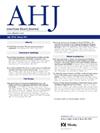经导管主动脉瓣置换术中脑栓塞保护装置对新发脑栓塞的影响:一项前瞻性前哨登记。
IF 3.5
2区 医学
Q1 CARDIAC & CARDIOVASCULAR SYSTEMS
引用次数: 0
摘要
背景:脑栓塞是经导管主动脉瓣置换术(TAVR)后常见的并发症。脑栓塞保护(CEP)装置具有减轻脑循环栓塞负担的潜力;然而,它们在现实世界中高卒中风险患者中的有效性仍未得到充分研究。方法:作为前瞻性哨兵登记(NCT05217888)影像学研究的一部分,我们通过脑磁共振成像(MRI)评估了CEP对经股动脉TAVR患者新发脑栓塞的影响,这些患者被认为是卒中高风险。主要终点是术后(2 - 7天)在脑MRI上新发脑病变的数量和体积,与受保护脑区域的基线相比。对照组由ADAPT-TAVR试验(NCT03284827)的入组患者组成,其中TAVR在不使用CEP装置的情况下进行。结果:共纳入219例患者(49例在SENTINEL登记,170例在ADAPT-TAVR试验)。对于主要终点,CEP组新发脑病变的数量和体积明显低于对照组。病变;1(四分位数间距[IQR], 1 ~ 2)和6 (IQR, 3 ~ 10);差,-4 [IQR, -6至-3];P3 (IQR, 42.4 ~ 206.9) vs. 283.5 mm3 (IQR, 129.7 ~ 682.4);差值,-145.9 [IQR, -296.7至-67.1];结论:在接受TAVR的卒中高风险患者中,CEP的使用与保护脑区域新发脑栓塞的显著减少相关。由于该研究在检测临床相关事件方面的能力不足,因此研究结果不能被认为具有临床指导意义。临床试验注册:http://ClinicalTrials.gov(标识符:NCT05217888)。本文章由计算机程序翻译,如有差异,请以英文原文为准。
Effect of cerebral embolic protection device on new cerebral embolism during transcatheter aortic valve replacement: A prospective sentinel registry
Background
Cerebral embolization is a common complication following transcatheter aortic valve replacement (TAVR). Cerebral embolic protection (CEP) devices have the potential to reduce embolic burden to the cerebral circulation; however, their effectiveness in real-world patients at high risk of stroke remains insufficiently studied.
Methods
As part of imaging study of the prospective Sentinel registry (NCT 05217888), we evaluated the effect of CEP on new cerebral embolism as determined by brain magnetic resonance imaging (MRI) in patients undergoing transfemoral TAVR who were considered at high risk for stroke. The primary endpoint was the number and volume of new cerebral lesions on brain MRI at postprocedure (2 to 7 days) compared to baseline in protected brain territories. The control group consists of enrolled patients in the ADAPT-TAVR trial (NCT03284827), in which TAVR was performed without the use of a CEP device.
Results
A total of 219 patients was included (49 in the SENTINEL registry and 170 patients in the ADAPT-TAVR trial). For the primary endpoint, the number and volume of new cerebral lesions was significantly lower in the CEP group than in the control group: the median no. of lesions; 1 (interquartile range [IQR], 1 to 2) vs 6 (IQR, 3 to 10), respectively; difference, -4 [IQR, -6 to -3]; P < .001, and the median volume of lesions; 113.5 mm3 (IQR, 42.4-206.9) vs 283.5 mm3 (IQR, 129.7-682.4), respectively; difference, -145.9 [IQR, -296.7 to -67.1]; P < .001). Strokes at 30 days occurred in 1 patient (2.0%) in the CEP group and 2 patients (1.2%) in the control group (P = .64).
Conclusions
Among patients who are at high risk for stroke undergoing TAVR, the use of CEP was associated with a significant reduction of new cerebral embolism in protected brain territories. Because the study was underpowered to detect clinically relevant events, the results cannot be considered clinically directive.
Clinical Trail Registration
http://ClinicalTrials.gov (Identifier: NCT05217888).
求助全文
通过发布文献求助,成功后即可免费获取论文全文。
去求助
来源期刊

American heart journal
医学-心血管系统
CiteScore
8.20
自引率
2.10%
发文量
214
审稿时长
38 days
期刊介绍:
The American Heart Journal will consider for publication suitable articles on topics pertaining to the broad discipline of cardiovascular disease. Our goal is to provide the reader primary investigation, scholarly review, and opinion concerning the practice of cardiovascular medicine. We especially encourage submission of 3 types of reports that are not frequently seen in cardiovascular journals: negative clinical studies, reports on study designs, and studies involving the organization of medical care. The Journal does not accept individual case reports or original articles involving bench laboratory or animal research.
 求助内容:
求助内容: 应助结果提醒方式:
应助结果提醒方式:


